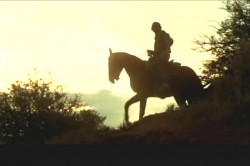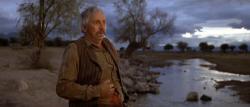Reviews
Monte Hellman
USA, 1965
Credits
Review by Cullen Gallagher
Posted on 02 April 2013
Source Vci Video DVD
Categories Acid Westerns
Pursuit is one of the dominant and everlasting themes of the Western genre. From manhunts like The Return of Draw Egan and Seven Men From Now to land hunts like The Big Trail and Meek’s Cutoff to animal hunts like Track of the Cat and Death Hunt, the Western reveals itself to be a performance based around movement and capture. Seen in this light, chasing dreams, chasing men, or chasing animals can all be interpreted as outward expressions of the emotions at the core of the genre: ambition, revenge, survival. Ride in the Whirlwind, directed by Monte Hellman and written by the film’s star, Jack Nicholson, abstracts this concept and distills it to its most potent and philosophical essence.
Nicholson plays the youngest of three drifters on their way to Waco stop overnight at a cabin inhabited by five outlaws. In the morning, a posse surrounds the cabin. They mistake the three drifters as part of the gang and pursue them into the mountains. The drifters hide out in a farmer’s home and hold his family hostage. When the posse catches up with them, the family is drawn into the conflict. When the surviving drifters escape, the posse follows, and the chase goes on.
The plot may be simple, but it hidden within in are multitudes of mysteries, uncertainties, and possibilities. Its ambiguity, however, is part of Ride in the Whirlwind’s attraction. The film continually subverts the goal- and justice-driven narratives that traditionally gave form, purpose, and direction to western films. In an ironic twist, it is the pursuit of justice has turned three innocent men into outlaws. Furthermore, this misunderstanding has given the drifters (who were on their way to Waco but without any specific job or purpose in mind) meaning and orientation to their journey. Whereas before they were wanderers with only the vaguest sense of either geographical, social, or spiritual orientation, their fight for survival has given meaning to their flight, conviction to their actions, and at least some sense of bearing to their movement.
The lack of any final destination, however, seems to be the most salient point of the narrative, and the aspect that most ties the film to its 1960s countercultural roots. If we approach the western genre as a creation myth of America, with Manifest Destiny being the battle cry that unified a nation’s efforts, then we can interpret Ride in the Whirlwind’s absence of destiny as a moment of cinematic and political defiance, breaking with the norms of the genre and questioning the moral direction of the nation’s history and present course of action. The worldwide social and artistic tumult that would explode in 1968 and 1969 was still years away when Ride in the Whirlwind was shot. And although it ultimately wouldn’t see wide release in America until 1969, after Easy Rider had made Jack Nicholson a certified star and proved that counterculture had wide box office appeal, Ride in the Whirlwind anticipates that later film’s iconography of the freewheeling drifter-as-political-anti-hero, as well as its portrayal of agents of law as agents of treachery and injustice, and its use of travel as a charged social metaphor.
Another of the film’s important themes can be found in the title, Ride in the Whirlwind: the ecstasy of the moment, in which the instant becomes eternity. This sense of being caught in the moment, of experiencing something ephemeral and chasing it in order to prolong the euphoria, is present in Hellman’s other films of the period, including The Shooting (filmed back-to-back with Ride in the Whirlwind), as well as Hellman’s other western, China 9, Liberty 37, and the road-movie-to-end-all-road-movies, Two-Lane Blacktop. Throughout Ride in the Whirlwind, Hellman’s camera seems to linger over the aura of a scene, such as when the outlaws standing silently in their dark shack while outside the light shines bright, or when the posse yells its verbal ultimatums in the canyon and the camera’s distant perspective and extended shot durations seem to observe the echo as it is absorbed by the mountain. In instances like these, nature overwhelms narrative.
Elusive to the end, Ride in the Whirlwind smartly avoids easy definition. Like the sole remaining drifter at the film’s conclusion, still doggedly pursed by the posse, the film remains tantalizingly in sight but perpetually out of reach.
More Acid Westerns
-

Ride in the Whirlwind
1965 -

The Shooting
1966 -

El Topo
1970 -

The Hired Hand
1971 -

The Last Movie
1971 -

Greaser’s Palace
1972 -

Bad Company
1972 -

Ulzana’s Raid
1972 -

Jeremiah Johnson
1972 -

Pat Garrett & Billy the Kid
1973 -

Kid Blue
1973 -

Dead Man
1995
We don’t do comments anymore, but you may contact us here or find us on Twitter or Facebook.



